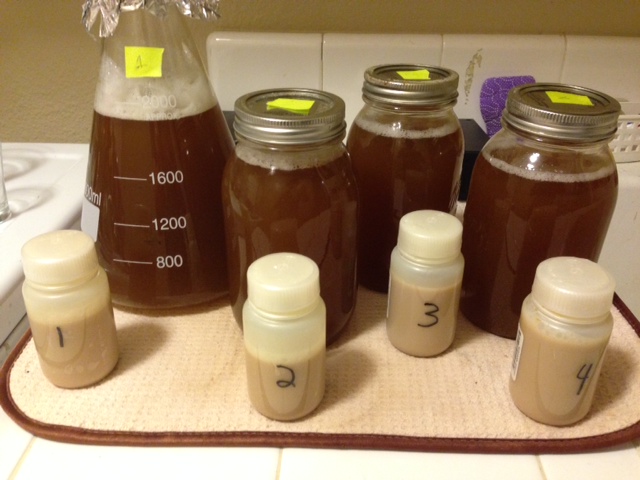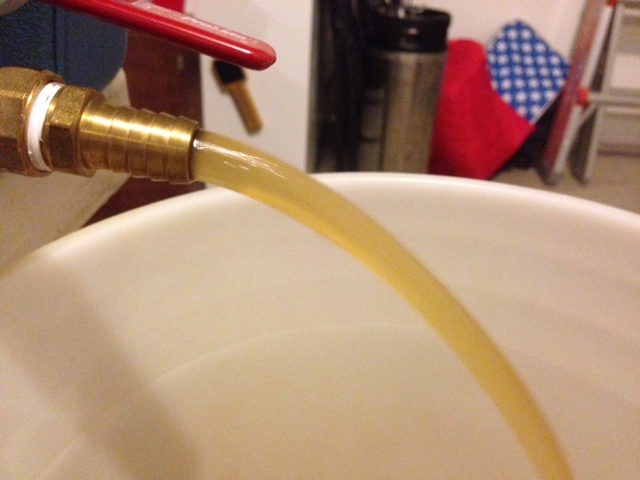Saison, with it’s high carbonation and spicy character, is a great style to drink and make, particularly during the warmer months, not only because it is incredibly refreshing, but because most Saison yeasts actually do better when fermented warmer. While some strains attenuate well at standard ale temps (e.g, Wyeast 3711 French Saison), others essentially require the temperature be raised an ungodly amount, sometimes as high as 90°F (e.g., WLP565 Belgian Saison), to achieve the dryness so characteristic of this style. This is enough to make many brewers, especially those of us who neurotically obsess over fermentation temps, a bit anxious. I’m always amazed, though, how great these beers come out despite the crazy temps.
As a beta tester for The Yeast Bay, the first set of yeasts Nick (owner) sent out for testing were all Saison strains, harvested from… well… I don’t know, actually. All he told us was he was sending each of us 4 Saison strains that he harvested, propagated, and labelled with numbers.
He wanted us to brew blind, which I found to be fucking exciting. Brewing as often as I do, it’s easy to lose that sense of wonder, brewing can become just another routine task. This opportunity is a welcome injection of novelty in my brewing life.
The 3 of us beta testers had an internet chat with Nick a couple weeks ago during which we nailed down a recipe and laid out the skeleton of a plan. We didn’t want anything getting in the way of the yeast character, so we settled on a simple and pretty traditional recipe:
Le Quatre Saisons
Batch Size: 10 gallons (packaged)
Target OG: 1.055
Target IBU: 20
Color: 4.5 SRM
Boil Time: 90 minutes
Grain Bill
70% Bohemian Pils Malt
20% White Wheat Malt
10% Munich Light (10L)
Hops
20 IBU Magnum @ 60
Nick provided each of us with different brewing parameters in order to see how the different yeasts perform given slightly different variables. I was tasked with mashing at 156°F and fermenting at 74°F. The 10 gallon batch was to be split 4 ways, 3 x 2 gallons and 1 x 4 gallons, with each beta tester pitching a different yeast into the larger batch that will later be split and pitched with a novel Brettanomyces strain. Ohhhhhhhh, baby!!
I hadn’t planned on brewing this beer until next weekend, mainly due to the time I spent helping out at the grand opening of House of Pendragon Brewing Co.’s taproom. Plans changed Sunday morning when my wife mentioned we were free most of Monday, plus I was too excited to wait! While largely unnecessary, I threw together some smaller starters just to get the yeast ready to go.
They were showing signs of activity within a few hours and fermenting madly by Sunday evening.
No stir plates were used, I only have 2 and wanted each starter to receive the same treatment. I did regularly agitate the and, surprisingly, had no blow-offs. The mason jar lids were not screwed on tight, I kept them very loose so CO2 could escape. Even in the starters, each yeast had very noticeable differences:
– Yeast 1 was the most pungent and obviously “Saison” with a slightly more fruity than spicy nose.
– Yeast 2 was more subtle, slightly cleaner, and smelled more traditionally Belgian, somewhat reminiscent of the Rochefort strain (WLP540).
– Yeast 3 was like a less powerful version of Yeast 1, very nice, and it seemed to have the biggest krausen.
– Yeast 4 was very interesting, smelling almost like lemon-lime soda with what seemed to me to be stronger CO2 production.
I milled my grain and collected all my water volumes the night before brewing, which is one of the few ways I’ve found to save a little time on brew days.
Per my usual brewing routine, I woke up at 4:00 AM on Monday and lit the flame under my HLT. It may sound nuts, but that’s the time I usually wake up for work, so it’s not as difficult as it seems. I added my grains to the strike water by 4:25 AM and nailed my mash temp.
I mash in 70 quart Coleman Xtreme coolers and stir every 20 minutes or so, a small change that increased and stabilized my efficiency, which sits right at 80%. After the 60 minute saccharification rest was complete, I collected my first runnings. Even after 10 years and 300+ batches, this part of the process is always a tad exciting for me- “science worked!”
After adding the 180°F sparge water and letting it rest for about 5 minutes, the second runnings were collected and added to the kettle.
My assistant, the Tiny Bottom Brewer, checked the pre-boil SG and gleefully reported, “It says 40 minutes!”
Translated, this meant we were clocking in at 1.046, exactly what BeerSmith said it should be. We cranked the burners and our sweet wort was boiling by about 6:00 AM.
Roscoe, my little brewer-in-training, was a big help!
After 30 minutes boiling, I made the only hop addition, 22 grams of Magnum at 60 minutes to flameout for a contribution of 20 IBU. I then prepped the 4 carboys.
I threw in a Whirlfloc tab and my King Cobra IC with 15 minutes left in the boil.
Once the timer went off, I cranked my faucet to full blast and began moving the wort and IC around with vigor. Even with 68°F groundwater, my King Cobra IC from JaDeD Brewing brought 11 gallons of wort from boiling to 72°F in just a hair under 14 minutes. I tested the OG using a refractometer, which gave a reading of 1.055, exactly what I planned for. I double-checked with a hydrometer for good measure.
The photo makes it look like it could be 1.056, I suppose this is due to how pale the wort is, but I assure you, the meniscus was smack on 1.055. Two gallons of wort was then racked into each 3 gallon Better Bottle and 4 gallons went into a 6 gallon plastic carboy. Once placed in my temperature controlled fermentation freezer, I attached the temp probe to the larger carboy and set the dual-stage regulator to maintain 74°F.
I always pitch 2°F cooler than my target fermentation temp out of habit, though I’m not sure it’ll have much impact on beer fermented at 74°F.
I harvested a small amount of yeast from each starter then pitched the remaining into their respectively numbered carboys. The first signs of activity were noticed within 2 hours and all 4 were showing decent krausen 6 hours after pitch.
The blend of smells emanating from the fermentation freezer was great, very Saison-esque in its fruity spiciness. By this morning, things were moving along nicely with every carboy of beer sitting at 74°F.
I’m not totally certain what the process will look like from here, still waiting to hear back from Nick about whether to ramp the temps up after 3-4 days like I might with other commercial Saison strains. Either way, I recently purchased four 3 gallon kegs that I plan to use for these beta tests (I’m really not a fan of bottling). I’m trying to decide now whether to force carb or naturally carb these beers in the keg, any opinions or suggestions are welcome!
***The new plan: I pitched at 72°, held it at 74° for ~24 hours, then turned the regulator way up, allowing the beer to naturally get as warm as 90° (shouldn’t get that warm). As of this morning (4/15/14), they were sitting at 77° and bubbling away.***
I’ll update the blog as this beer progresses. Until then…
Cheers!


























7 thoughts on “The Yeast Bay: Les Quatre Saisons”
A month later and I’m wondering, what temps your fermentation topped out at, what your final gravity readings were and how they’ve turned out. Partly because I love Belgian Ales but mostly because I’m using the Saison Blend this weekend and love pushing WLP565 and 566 into the upper 80’s, lower 90’s.
A blog post with all of the updates will be coming shortly, but the fermentation temp topped out at 85°. Cheers!
Did this ever get an update? I can’t seem to find it on your site.
Error… It didn’t. I really ought to get to that.
Any news now? I know the focus of the site has shifted but would love to hear the conclusion.
None of the strain impresses Nick enough to release, at least on their own. I just had the last bottle of what I had in stock, was decent, but not mind blowing.
🙁